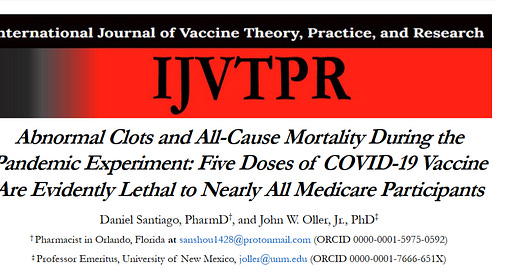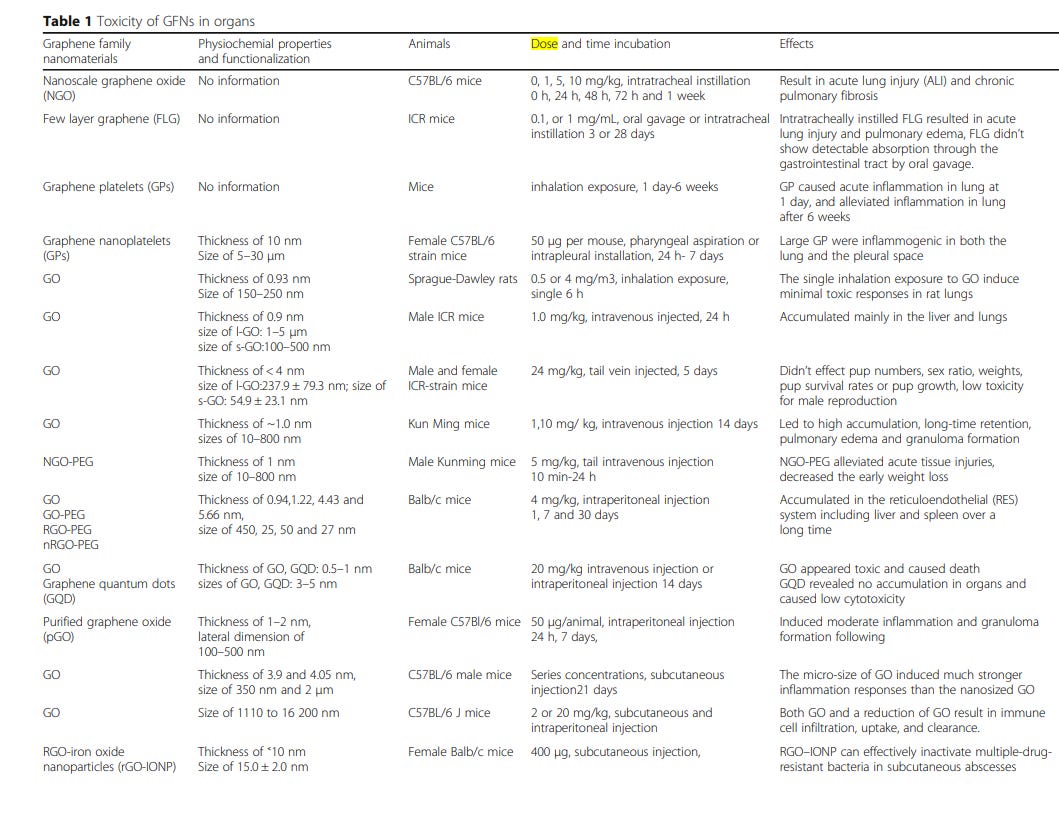THIS IS OUTRAGEOUS The dose makes the poison!
1 out of 57,261Survived to Take a 7th Dose and Died!
It's POISON, and the people behind it are MURDERERS:
https://ijvtpr.com/index.php/IJVTPR/article/view/73/213
Introduction
There have been reports of extraordinary abnormal clots being removed from both living (Dong & Corson, 2022) and dead (Crowder & O'Looney, 2022; O’Looney et al., 2022; Trigoso, 2022) individuals who received one or more doses of aCOVID-19 injectable, or some mix of more than one. By February 22, 2023 the in vivo experimental genetic therapy had already been administered in 13.29 billion doses —with 1,695,567 doses being added to the total in just one day in the still unfolding true narrative representation (see TNR-theory in Oller, 2014). When we started writing this paper, of the approximately 8 billion people on the planet, more than 5 billion (62.5% of the whole world’s population) qualified as “fully vaccinated”.
This paper addresses the central clinical outcome question:
What is now pushing upward the abnormally high level of deaths from all-causes in the most heavily vaccinated populations of the world, especially in the USA?3
https://www.annualreviews.org/doi/pdf/10.1146/annurev-pharmtox-032320-110338
Nanoparticle toxicity may occur as a function of exposure route, dose, concentration, time, and/or frequency.
IT IS WORTH READING THE WHOLE ARTICLE:
https://particleandfibretoxicology.biomedcentral.com/articles/10.1186/s12989-016-0168-y Toxicity of graphene-family nanoparticles: a general review of the origins and mechanisms | Particle and Fibre Toxicology | Full Text (biomedcentral.com)
Toxicity in internal organs GO can result in acute inflammation response and chronic injury by interfering with the normal physiological functions of important organs [32, 81].
Interesting, a low dose of GO caused serious damage to the gastrointestinal tract after maternal mice drank a GO suspension rather than a high-dose of GO because a low dose of GO without agglomeration can easily attach to the gastrointestinal surface and cause destruction through its abundant sharp edges [53]. GFNs caused inflammation and remained in the lung on day 90 after a single intratracheal instillation, and even translocated to lung lymph nodes by a nose-only inhalation [96, 97]. A high dose of GO that forms aggregations can block pulmonary blood vessels and result in dyspnea [50, 98], and platelet thrombi were observed at high concentrations of 1 and 2 mg/kg body weight via intravenous injection [89]. GO reportedly disrupted the alveolar capillary barrier, allowing inflammatory cells to infiltrate into the inflammatory cytokines [99]
In addition, radioactive isotopes can be delivered into the lungs, accompanied by a depth distribution of 125I-NGO in the lungs, and the isotopes might deposit there and result in mutations and cancers [30].
However, the pregnant mice had abortions at all dose, and most pregnant mice died when the high dose of rGO was injected during late gestation [44]. Notably, the development of offspring in the high dosage group was delayed during the lactation period. The high dose of GO decreased the maternal mice’s water consumption by oral exposure, which reduced milk production and thus postponed the growth of offspring [53]. Though the findings indicate that GFNs are potentially harmful to development, but data on reproductive and developmental toxicity are still deficient.
We investigate the toxicity issues of anti‐CoV NPs
(i.e., plasmonic NPs and quantum dots)
on different levels. Namely, nano–bio interfaces (i.e., protein corona), in vitro (i.e., lung cells) and in vivo (i.e., zebrafish embryos) assessments, and impacts on humans are discussed in a narrative supported by original figures.
Ultimately, we express our skeptical opinion on the comprehensive administration of such antiviral nanotheranostics, even when integrated into facemasks, because of their reported toxicities and the different NP parameters (e.g., size, shape, surface charge, and purity and chemical composition of NPs) that govern their end toxicity.
We believe that more toxicity studies should be performed and be presented, clarifying the odds of the safe administration of nanotoxocological solutions and the relief of a worried public.
The toxicity issues surrounding quantum dots (QDs) are a disputed subject regarding their biomedical applications. These toxicity issues and beliefs emerge from the toxicity of cadmium‐containing QDs towards cultured cells, with their toxicity towards humans and in all of their other forms being extrapolated on the basis their being homogeneous materials. However, this extrapolation is refuted by the lack of studies demonstrating such toxicities in animal models and the heterogeneity of the unique physicochemical properties of various QDs [48].
https://www.ncbi.nlm.nih.gov/pmc/articles/PMC7379444/pdf/turkjmedsci-50-1180.pdf
5.2.3. Dosage Nanomaterials are known to have dose-dependent toxic effects by inhalation, and there are many publications regarding this issue.
In studies conducted to reveal the possible toxic effects of NPs on human health, NPs of different character were applied in different ways (inhalation, intratracheal, intravenous, intraperitoneal, etc.) and in different doses, and parameters such as transition to systemic circulation in living organisms, accumulation in tissues, inflammation in tissues, other immune responses and excretion of NPs from the body have been studied. In a study conducted in five healthy volunteers, it has been observed that ultrafine carbon particles smaller than 100 nm quickly enter the systemic circulation in a short time like 10 minutes after inhalation and maintain their level in the systemic circulation for about an hour [54].
Nanoparticles with short size and spiral structure entering the body are destroyed in tissues by macrophages. However, nanotubes with high aspect ratio reach to the pleura like asbestos fibers and accumulate around the pores there. These fibrous particles cannot be phagocyted, and proinflammatory, genotoxic mitogenic mediators are released by mesothelial cells. Thus, an inflammation and damage process begin [56]. This inflammation that starts in the lungs, on the one hand causes pulmonary endothelial dysfunction and stimulation of pulmonary reflexes, on the other hand activates the platelets and increases the thrombotic activity. In addition, inflammation in the vascular area can cause vascular endothelial dysfunction, causing cardiovascular disorders such as impaired heart rate and rhythm, atherosclerotic plaque formation and rupture [52]. Nanoparticles stimulate both natural and acquired immunity, and causing an inflammatory response. Stimulation of both the macrophage/monocyte, neutrophil, dendritic, natural killer cells responsible for natural immunity and the dendritic cells and lymphocyte responsible for acquired immunity, proinflammatory cytokines, lipid mediators and free radicals are released, resulting in neutrophilic or eosinophilic lung inflammation.
9. Toxicity mechanisms of nanoparticles Mechanical effects due to the physicochemical properties of nanoparticles cause toxicity. The basic mechanism of toxic effect formation is reactive oxygen species (ROS) formation, either directly or indirectly. ROS formation is toxic in vitro by multiple mechanisms in the cell [93]. ATP synthesis in mitochondria occurs as a result of the reduction of molecular oxygen to water. During this event superoxide anions and radicals containing different oxygen are formed. ROS formed are known as hydroxyl radical, single oxygen, hydrogen peroxide and superoxide anion radicals [94]. Overproduction of these radicals, which play a role in mitogenic response and cellular signaling and leads to disruption of physiological functions in cells [95,96]. The damage caused by nanomaterials to the cell is cytotoxic and genotoxic (Figure 5). Since nanomaterials have small dimensions, they cause more ROS production due to their specific surface area and high surface reactivity [97].
















"...INDIVIDUALS, COMPANIES AND ORGANIZATIONS THAT CONCOCTED THIS CRIMINAL SCHEME SHOULD PAY THE VICTIMS FOR THESE CRIMES..."
NO. They should be hanged. And the companies destroyed and the assets sold to pay the victims. SCORCHED EARTH!!!
outragous axeually